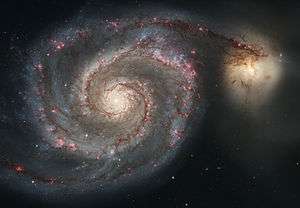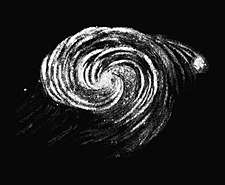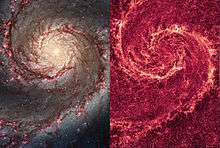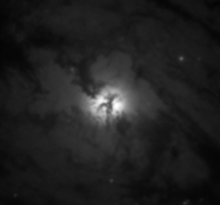Whirlpool Galaxy
| Whirlpool Galaxy | |
|---|---|
 Whirlpool Galaxy (M51A or NGC 5194). The smaller object in the upper right is M51B or NGC 5195. | |
| Observation data (J2000 epoch) | |
| Constellation | Canes Venatici[1] |
| Right ascension | 13h 29m 52.7s[2] |
| Declination | +47° 11′ 43″[2] |
| Redshift | 0.001544[2] |
| Distance | 23 Mly (7.1 ± 1.2 Mpc)[3][4] |
| Apparent magnitude (V) | 8.4[5] |
| Characteristics | |
| Type | SA(s)bc pec[2] |
| Size | ~60,000ly in diameter[6] |
| Apparent size (V) | 11′.2 × 6′.9[2] |
| Notable features | Interacting with NGC 5195[7] |
| Other designations | |
| Question Mark Galaxy,[2] Rosse's Galaxy,[2] M51a,[2] NGC 5194,[2] UGC 8493,[2] PGC 47404,[2] VV 001a,[2] VV 403,[2] Arp 85,[2] GC 3572[2] | |
The Whirlpool Galaxy, also known as Messier 51a, M51a, and NGC 5194, is an interacting grand-design spiral galaxy with a Seyfert 2 active galactic nucleus.[8][7][9] It lies in the constellation Canes Venatici, and was the first galaxy to be classified as a spiral galaxy.[10] Its distance is estimated to be between 15 and 35 million light-years.[3]
The galaxy and its companion, NGC 5195,[11] are easily observed by amateur astronomers, and the two galaxies may be seen with binoculars.[12] The Whirlpool Galaxy has been extensively observed by professional astronomers, who study it to understand galaxy structure (particularly structure associated with the spiral arms) and galaxy interactions.
Discovery

What later became known as the Whirlpool Galaxy was discovered on October 13, 1773, by Charles Messier while hunting for objects that could confuse comet hunters, and was designated in Messier's catalogue as M51.[13] Its companion galaxy, NGC 5195, was discovered in 1781 by Pierre Méchain, although it was not known whether it was interacting or merely another galaxy passing at a distance. In 1845, William Parsons, 3rd Earl of Rosse, employing a 72-inch (1.8 m) reflecting telescope at Birr Castle, Ireland, found the Whirlpool possessed a spiral structure, the first "nebula" to be known to have one. These "spiral nebulae" were not recognized as galaxies until Edwin Hubble was able to observe Cepheid variables in some of these spiral nebulae, which provided evidence that they were so far away that they must be entirely separate galaxies even though they are seen close together .[14]
The advent of radio astronomy and subsequent radio images of M51 unequivocally demonstrated that the Whirlpool and its companion galaxy are indeed interacting. Sometimes the designation M51 is used to refer to the pair of galaxies, in which case the individual galaxies may be referred to as M51a (NGC 5194) and M51b (NGC 5195).
Visual appearance

Located within the constellation Canes Venatici, M51 is found by following the easternmost star of the Big Dipper, Eta Ursae Majoris, and going 3.5° southwest. Its declination is +47°, making it a circumpolar for observers located above 43°N latitude; it reaches high altitudes throughout the northern hemisphere making it an accessible object from the early hours in winter through the end of spring season, after which observation is hindered in lower latitudes.
M51 is visible through binoculars under dark sky conditions, and it can be resolved in detail with modern amateur telescopes.[12] When seen through a 100 mm telescope the basic outlines of M51 (limited to 5x6') and its companion are visible. Under dark skies, and with a moderate eyepiece through a 150 mm telescope, M51's intrinsic spiral structure can be detected. With larger (>300 mm) instruments under dark sky conditions, the various spiral bands are apparent with HII regions visible, and M51 can be seen to be attached to M51B.
As is usual for galaxies, the true extent of its structure can only be gathered from inspecting photographs; long exposures reveal a large nebula extending beyond the visible circular appearance.
In January 2005 the Hubble Heritage Project constructed a 11477 × 7965-pixel composite image (shown in the infobox above) of M51 using Hubble's ACS instrument. The image highlights the galaxy's spiral arms, and shows detail into some of the structures inside the arms.[15]
Properties


M51a lies 30 million light years from Earth and has an estimated diameter of 60,000 light years.[12] Overall the galaxy is about 25–33% the size of the Milky Way. Its mass is estimated to be 160 billion solar masses.[16]
A black hole, surrounded by a ring of dust, is thought to exist at the heart of the spiral. The dust ring stands almost perpendicular to the relatively flat spiral nebula. A secondary ring crosses the primary ring on a different axis, a phenomenon that is contrary to expectations. A pair of ionization cones extend from the axis of the main dust ring.[17]
Spiral structure
The pronounced spiral structure of the Whirlpool Galaxy is believed to be the result of the close interaction between it and its companion galaxy NGC 5195, which may have passed through the main disk of M51 about 500 to 600 million years ago. In this proposed scenario, NGC 5195 came from behind M51 through the disk towards the observer and made another disk crossing as recently as 50 to 100 million years ago until it is where we observe it to be now, slightly behind M51.[18]
Star formation
The central region of M51 appears to be undergoing a period of enhanced star formation. The present efficiency of star formation, defined as the ratio of mass of new stars to the mass of star-forming gas, is only ~1%, quite comparable to the global value for the Milky Way and other galaxies. It is estimated that the current high rate of star formation can last no more than another 100 million years or so. [19]
Transient events
Three supernovae have been observed in the Whirlpool Galaxy.[20] In 1994, SN 1994I was observed in the Whirlpool Galaxy. It was classified as type Ic, indicating that its progenitor star was very massive and had already shed much of its mass, and its brightness peaked at apparent magnitude 12.91.[21]
In June 2005 the type II supernova SN 2005cs was observed in the Whirlpool Galaxy, peaking at apparent magnitude 14.[22][23]
On 31 May 2011 a type II supernova was detected in the Whirlpool Galaxy, peaking at magnitude 12.1.[24] This supernova, designated SN 2011dh, showed a spectrum much bluer than average, with P Cygni profiles, which indicate rapidly expanding material, in its hydrogen-Balmer lines.[25] The progenitor was probably a yellow supergiant[26] and not a red or blue supergiant, which are thought to be the most common supernova progenitors.
Companion
.jpg)
NGC 5195 (also known as Messier 51b or M51b) is a dwarf galaxy that is interacting with the Whirlpool Galaxy (also known as M51a or NGC 5194). Both galaxies are located approximately 25 million light-years away in the constellation Canes Venatici. Together, the two galaxies are one of the most widely studied interacting galaxy pairs.
Galaxy group information
The Whirlpool Galaxy is the brightest galaxy in the M51 Group, a small group of galaxies that also includes M63 (the Sunflower Galaxy), NGC 5023, and NGC 5229.[27][28][29][30] This small group may actually be a subclump at the southeast end of a large, elongated group that includes the M101 Group and the NGC 5866 Group, although most group identification methods and catalogs identify the three groups as separate entities.[31]
See also
| Wikimedia Commons has media related to Whirlpool Galaxy. |
- Messier object
- List of Messier objects
- New General Catalogue
- List of galaxies
- NGC 5195 – the companion galaxy to NGC 5194
- Messier 101 – another grand-design spiral galaxy
- M51 in fiction
References
- ↑ Dreyer, J. L. E. (1988). Sinnott, R. W., ed. The Complete New General Catalogue and Index Catalogue of Nebulae and Star Clusters. Sky Publishing Corporation/Cambridge University Press. ISBN 978-0-933346-51-2.
- 1 2 3 4 5 6 7 8 9 10 11 12 13 14 15 "NASA/IPAC Extragalactic Database". Results for NGC 5194. Retrieved December 6, 2006.
- 1 2 Takáts, K.; Vinkó, J. (2006). "Distance estimate and progenitor characteristics of SN 2005cs in M51". Monthly Notices of the Royal Astronomical Society. 372 (4): 1735. arXiv:astro-ph/0608430. Bibcode:2006MNRAS.372.1735T. doi:10.1111/j.1365-2966.2006.10974.x.
- ↑ "Distance Results for MESSIER 051". NASA/IPAC Extragalactic Database. Retrieved June 6, 2011.
- ↑ "M51". SEDS.org.
- ↑ "The Whirlpool Galaxy". NASA. February 26, 2013. Retrieved October 11, 2018.
- 1 2 Elmegreen, D. M.; Elmegreen, B. G. (1987). "Arm classifications for spiral galaxies". Astrophysical Journal. 314: 3–9. Bibcode:1987ApJ...314....3E. doi:10.1086/165034.
- ↑ Arp, H. (1966). "Atlas of Peculiar Galaxies". Astrophysical Journal Supplement. 14: 1–20. Bibcode:1966ApJS...14....1A. doi:10.1086/190147.
- ↑ Matsushita, Satoki; Muller, Sebastien; Lim, Jeremy (9 April 2007). "Jet-disturbed molecular gas near the Seyfert 2 nucleus in M51". Astronomy & Astrophysics. 468 (A&A Letters Special Issue): L49–L52. arXiv:0704.0947. Bibcode:2007A&A...468L..49M. doi:10.1051/0004-6361:20067039.
- ↑ "Whirlpool Galaxy: First Spiral Galaxy". Universe for Facts. Retrieved 21 December 2014.
- ↑ https://messierobjects101.com/messier-object-m51/
- 1 2 3 Nemiroff, R.; Bonnell, J., eds. (February 24, 2013). "M51: The Whirlpool Galaxy". Astronomy Picture of the Day. NASA. Retrieved October 11, 2018.
- ↑ Messier, Charles (1781). "Catalogue des Nébuleuses & des amas d'Étoiles". Connaissance des Temps [1784]. pp. 227–267 [246].
- ↑ Hubble, E. P. (1929). "A spiral nebula as a stellar system, Messier 31". Astrophysical Journal. 69: 103–158. Bibcode:1929ApJ....69..103H. doi:10.1086/143167.
- ↑ "Out of This Whirl: the Whirlpool Galaxy (M51) and Companion Galaxy". News Center. HubbleSite. April 25, 2005. Retrieved August 7, 2006.
- ↑ "Whirlpool Galaxy". Herschel Space Observatory. Cardiff University. June 19, 2009. Retrieved October 11, 2018.
- ↑ "NASA's Hubble Space Telescope Resolves a Dark "x" Across the Nucleus of M51". News Center. HubbleSite. June 8, 1992. Retrieved August 7, 2006.
- ↑ Salo, Heikki; Laurikainen, Eija (1999). "A Multiple Encounter Model of M51". Astrophysics and Space Science. 269: 663–664. Bibcode:1999Ap&SS.269..663S. doi:10.1023/A:1017002909665.
- ↑ Thronson, Harley A.; Greenhouse, Matthew A. (1988). "Near-Infrared Mass-to-light ratios in Galaxies: Stellar Mass and Star Formation in the Heart of the Whirlpool". The Astrophysical Journal. 327: 671–679. Bibcode:1988ApJ...327..671T. doi:10.1086/166224.
- ↑ "List of Supernovae". Central Bureau for Astronomical Telegrams. Retrieved February 27, 2016.
- ↑ Sauer, D. N.; Mazzali, P. A.; Deng, J.; Valenti, S.; et al. (2006). "The properties of the `standard' Type Ic supernova 1994I from spectral models". Monthly Notices of the Royal Astronomical Society. 369 (4): 1939–1948. arXiv:astro-ph/0604293. Bibcode:2006MNRAS.369.1939S. doi:10.1111/j.1365-2966.2006.10438.x.
- ↑ MacRobert, Alan M. (August 24, 2005). "Supernova in M51". Sky Tonight. Sky and Telescope. Retrieved August 7, 2006.
- ↑ Bishop, David. "Supernova 2005cs in M51". supernovae.net. Archived from the original on October 3, 2006. Retrieved August 7, 2006.
- ↑ Bishop, David. "Supernovae 2011dh in M51". supernovae.net (International Supernovae Network). Retrieved 2011-06-06.
- ↑ Kinne (kqr), Richard (2011-06-03). "AAVSO Special Notice #241: New Supernova in M51". AAVSO. Retrieved 2011-06-06.
- ↑ "ATEL 3401: Properties of the Candidate Progenitor of SN 2011dh in M51". Astronomers Telegram. 2011-06-03. Retrieved 2011-06-06.
- ↑ Tully, R. B. (1988). Nearby Galaxies Catalog. Cambridge University Press. ISBN 978-0-521-35299-4.
- ↑ Fouque, P.; Gourgoulhon, E.; Chamaraux, P.; Paturel, G. (1992). "Groups of galaxies within 80 Mpc. II - The catalogue of groups and group members". Astronomy and Astrophysics Supplement. 93: 211–233. Bibcode:1992A&AS...93..211F.
- ↑ Garcia, A. (1993). "General study of group membership. II - Determination of nearby groups". Astronomy and Astrophysics Supplement. 100: 47–90. Bibcode:1993A&AS..100...47G.
- ↑ Giuricin, G.; Marinoni, C.; Ceriani, L.; Pisani, A. (2000). "Nearby Optical Galaxies: Selection of the Sample and Identification of Groups". Astrophysical Journal. 543 (1): 178–194. arXiv:astro-ph/0001140. Bibcode:2000ApJ...543..178G. doi:10.1086/317070.
- ↑ Ferrarese, L.; Ford, H. C.; Huchra, J.; Kennicutt Jr., R. C.; et al. (2000). "A Database of Cepheid Distance Moduli and Tip of the Red Giant Branch, Globular Cluster Luminosity Function, Planetary Nebula Luminosity Function, and Surface Brightness Fluctuation Data Useful for Distance Determinations". Astrophysical Journal Supplement. 128 (2): 431–459. arXiv:astro-ph/9910501. Bibcode:2000ApJS..128..431F. doi:10.1086/313391.
External links
- StarDate: M51 Fact Sheet
- M51: Calar Alto Observatory
- SEDS: Spiral Galaxy M51
- NASA Astronomy Picture of the Day: M51: The Whirlpool Galaxy in Dust and Stars (10 April 2001)
- Whirlpool Galaxy at ESA/Hubble
- The Whirlpool Galaxy (Messier 51(a)/NGC 5194)
- Servicio de repación oficial Whirlpool
- M51 The Whirlpool Galaxy
- The Whirlpool Galaxy at Constellation Guide
- The Whirlpool Galaxy on WikiSky: DSS2, SDSS, GALEX, IRAS, Hydrogen α, X-Ray, Astrophoto, Sky Map, Articles and images
